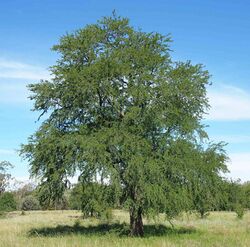Biology:Lysiphyllum hookeri
| Lysiphyllum hookeri | |
|---|---|

| |
| Habit | |
| Scientific classification | |
| Kingdom: | Plantae |
| Clade: | Tracheophytes |
| Clade: | Angiosperms |
| Clade: | Eudicots |
| Clade: | Rosids |
| Order: | Fabales |
| Family: | Fabaceae |
| Genus: | Lysiphyllum |
| Species: | L. hookeri
|
| Binomial name | |
| Lysiphyllum hookeri (F.Muell.) Pedley
| |
| Synonyms | |
| |
Lysiphyllum hookeri is a species of small tree endemic to Queensland, Australia, of the legume plant family Fabaceae. These trees are known by a variety of common names, including pegunny, alibangbang, Hooker's bauhinia, white bauhinia, mountain ebony and Queensland ebony.[1][2]
Taxonomy
It, along with the rest of the genus Lysiphyllum was formerly treated as part of the genus Bauhinia.[1][3][4][5] However, molecular phylogenetic analysis confirms that Lysiphyllum is a distinct genus from Bauhinia.[6][7][8][9][10]
Range and habitat
These trees grow naturally in monsoon forest, littoral rainforest and occasionally in more open forest types in north-eastern Australia.[1] It has also been widely cultivated throughout Australia and the pacific region as a drought-tolerant ornamental plant.[2][11]
Description
As with most members of the genus, this species produces compound leaves with only a single pair of leaflets, producing a bi-lobed leaf that resembles the wings of a butterfly. Showy white flowers are produced throughout the year dependent on rainfall, and are accented by long red stamens. They also have a lovely delicate scent. The flowers are followed by flat pods containing multiple seeds.
References
- ↑ 1.0 1.1 1.2 "Bauhinia hookeri". Centre for Australian National Biodiversity Research (CANBR), Australian Government. 2020. https://apps.lucidcentral.org/rainforest/text/entities/Bauhinia_hookeri.htm.
- ↑ 2.0 2.1 Small Trees for the Tropical Landscape: A Gardener's Guide. Honolulu, Hawaii, USA: University of Hawaiʻi Press. 2009. pp. 207. ISBN 978-0824833084. https://archive.org/details/smalltreesfortro00rauc.
- ↑ "Bauhinia hookeri". Australian Plant Name Index (APNI), IBIS database. Centre for Plant Biodiversity Research, Australian Government. http://www.anbg.gov.au/cgi-bin/apni?taxon_id=58712.
- ↑ "Lysiphyllum hookeri". Australian Plant Name Index (APNI), IBIS database. Centre for Plant Biodiversity Research, Australian Government. http://www.anbg.gov.au/cgi-bin/apni?taxon_id=28044.
- ↑ Census of the Queensland Flora 2010. Brisbane: Queensland Herbarium, Department of Environment and Resource Management. 2010. p. 35. ISBN 978-1920928193. http://www.ehp.qld.gov.au/plants/census_qld_flora.html. Retrieved 28 May 2013.
- ↑ "Lysiphyllum" (Online, at kew.org). Legumes of the World. London, England: Royal Botanic Gardens, Kew. http://www.kew.org/science-research-data/lowo/TaxonomicView/SubFamily/Tribe/Genus/index.htm?kew_lowo_accepted_name_path=Lysiphyllum.
- ↑ "Phylogenetic Relationships in the Caesalpinioideae (Leguminosae) as Inferred from Chloroplast trnL Intron Sequences". Syst Bot 26 (3): 487–514. 2001. doi:10.1043/0363-6445-26.3.487. http://www.bioone.org/doi/full/10.1043/0363-6445-26.3.487.
- ↑ "Phylogenetic relationships in caesalpinioid legumes: a preliminary analysis based on morphological and molecular data". Advances in Legume Systematics, Part 10: Higher Level Systematics. Royal Botanic Gardens, Kew. 2003. pp. 37–62. ISBN 978-1-84246-054-2.
- ↑ "Phylogenetic patterns and diversification in the caesalpinioid legumes". Botany 86 (7): 697–718. 2008. doi:10.1139/b08-058.
- ↑ "The genus Bauhinia s.l. (Leguminosae): a phylogeny based on the plastid trnL–trnF region". Botany 87 (10): 947–960. 2009. doi:10.1139/B09-065.
- ↑ "Bauhinia hookeri (Mountain ebony)" (Online, at starrenvironmental.com). Plants of Hawaii. Hawaii: Starr Environmental. http://www.starrenvironmental.com/images/species/?q=bauhinia+hookeri&o=plants.
Wikidata ☰ Q15531520 entry
 |



